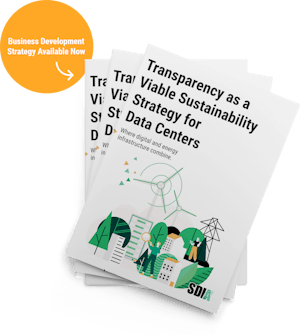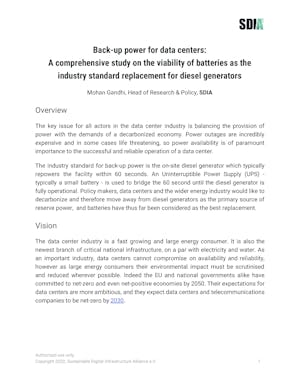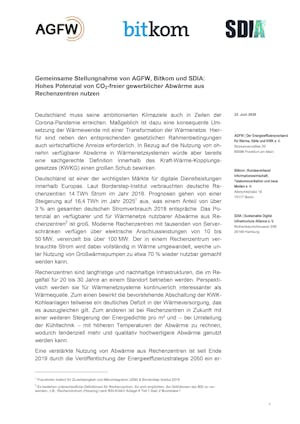Our Publications
Knowledge sharing and transparency are at the heart of our organization. Access our latest vision, research, policy and white papers, reports, announcements, press releases and articles.
Document
Verification Report for the Dynatrace Cost & Carbon Optimization Tool
Dynatrace commissioned the SDIA to review, test, and validate the assumptions
and calculations made by their Cost and Carbon Optimization app to estimate
greenhouse gas (GHG) emissions. This report summarizes the findings and
recommendations resulting from the engagement.
Document
Comments on EU Delegated Act for a common reporting scheme to rate the sustainability of data centres in the EU
The Sustainable Digital Infrastructure Alliance (SDIA) provides comprehensive feedback on the European Union's Delegated Act for a common Union rating scheme for data centers. Emphasizing the need for holistic indicators that span resource inputs to IT equipment and network traffic impacts, SDIA advocates for earlier reporting deadlines to monitor infrastructure growth effectively. The Alliance calls for greater transparency, advocating for the public release of detailed environmental performance data to foster accountability, enable civil society research, and support sustainable digital economy development. Through its suggestions, SDIA aims to strengthen the draft in alignment with EU goals for sustainability and transparency.
Position Paper
Green Software Position Paper: Transparency, Standards, Market-Making
This comprehensive Position Paper from the SDIA Green Coding Summit provides a detailed exploration of the environmental impact of software development. It identifies key challenges such as lack of visibility into software's environmental costs, the need for standardized definitions and measurements, and the limited market for Green Software.
The paper defines "Green Software" and elaborates on the disciplines required for its development, including Green Coding, Green Requirements Engineering, and Green Operations. It also discusses the importance of distinguishing environmental impact from carbon emissions, and outlines strategies for raising awareness, setting standards, and increasing demand for Green Software.
Additionally, it presents political demands to support sustainable software practices, making it a must-read for industry professionals, policymakers, and anyone interested in the intersection of technology and sustainability. Download the full PDF to explore how the Sustainable Digital Infrastructure Alliance is leading the charge in creating a more sustainable digital future.
Position Paper
Public Cloud Providers: How and why to regulate digital resource utility companies
This document outlines the challenges and potential opportunities for creating a fair and equitable cloud infrastructure market. To understand the cloud market, its business models and infrastructure, it is helpful to compare it to another critical infrastructure sector – the energy sector. The similarities are striking. We can apply many of the regulatory and policy lessons-learned from the development of the energy sector to the cloud infrastructure industry, as the economic issues are so similar.
Document
List of impact indicators for software
An overview of relevant impact metrics - environmental, resource usage, waste and output flow based on the EN15804 +A2 standard for life cycle assessments in the construction sector.
Commentary
The Energy Efficiency Directive: Text of the trilogue agreement between the European Council and Parliament
On transparency and heat recovery, this new Directive is a major milestone. We look forward to supporting the implementation of the EED into law
Commentary
Comments on the Task A document dated 28/11/2022 supplied by Viegand Maagøe and COWI on behalf of the EU Commission regarding the Energy Efficiency Directive
Co-created and aggregated by the Sustainable Digital Infrastructure Alliance e.V. and the following collaborators, each of which is a signatory of the document: Jens Gröger, Marc Wilkens, Gaia Balzarini, Giuseppe Leto, Quentin Laurens, Raphael Daniel, Prof. Patricia Lago, Max Schulze.
Whitepaper
Creating a digital environmental footprint: a Life Cycle Assessment approach
With the Digital Environmental Footprint as the first activity on the Roadmap of the SDIA, we aim to bring together experts and make fruitful connections to develop an open methodology to assess the digital environmental footprint of digital products and services.
We have chosen to build on the Life Cycle Assessment (LCA) methodology, since the information revealed through performing an assessment can give us what we need to report on our environmental impact, improving digital products and services, and therefore our businesses.
Read our article on this paper on our blog.
Whitepaper
Building a Sustainable, Federated European Cloud: A Vision for Europe
This document outlines the vision for a sustainable and accessible European cloud; one that will be open-source, fair, and create economic opportunities for all. Despite existing challenges, it is possible and may soon become a reality. Such digital infrastructure will reflect European values and provide a blueprint that others around the world can draw inspiration from to further develop their own digital economies.
Commentary
Commentary on the Energy Efficiency Directive
We welcome this opportunity to share our comments on this recast of the Energy Efficiency Directive (EED).
Research Paper
Developing a Circular Economy for the Data Centre Industry: The CEDaCI project
This paper describes the whole-systems approach and CEDaCI project outputs, including bespoke Eco-design guidelines, strategies, and digital tools to extend product life and recycling, and enable better decision-making to increase circularity in the DCI, prepare and support implementation of the EU Circular Economy Action Plan and ensure a secure, sustainable resource supply chain.
Research Paper
Retrofitting of an air-cooled data center for energy efficiency
Small-scale data centers suffering from low cooling efficiency consume an intense power for reliable operation of IT equipment. In this study, thermal distribution in an air-cooled data center is simulated using an open source Computational Fluid Dynamics (CFD) model to examine the underlying mechanism that reduces thermal and cooling efficiencies. The numerical model is validated with the temperature measurements conducted in the data center.
Whitepaper
The Cooling Requirements of Data Centers
Concerns regarding the environment, energy efficiency, and compute density are playing a big role in the future of HPC facilities and data center designs. Liquid-cooling is an order of magnitude more efficient at cooling IT equipment, and as such, it is becoming an integral part of future strategies and a valuable alternative to air-cooling for existing data centers.
Whitepaper
On-site Power Generation for Data Centers
This paper is an output from our Steering Groups and sheds light on the opportunities and challenges to the genuine decarbonization of data centers.
Whitepaper
Sustainability Strategy for Data Centers
This paper explores how transparency and open data can be a viable sustainability strategy for data centers and also shows how you can implement this strategy.
Whitepaper
Battery Study
Back-up power for data centers: A comprehensive study on the viability of batteries as the industry standard replacement for diesel generators.
Document
The Utility of the Future Report
Both energy and digitalization are on everybody's minds today. Both play increasingly important roles in our daily lives, yet few realise how interdependent these industries truly are. Digitalization promises to re-align our economy around data and computation, but the digital economy of tomorrow will be built on the shoulders of today’s electrical infrastructure. Fewer still can see the tremendous industrial and societal opportunities when two fundamental requirements of the digital age integrate.
Position Paper
High potential of CO2-free commercial waste heat from data centers (German paper)
In a joint statement of the SDIA with the Energieeffizienzverband für Wärme, Kälte und KWK e. V. (Energy Efficiency Association for Heating, Cooling and CHP - AGFW) and Bitkom e. V. we express the urgent need to adjust the definition of waste heat in the upcoming changes to the Combined Heat and Power Act (KWKG) in Germany in order to support the use of waste heat from data centers as a climate-neutral and sustainable energy source.




.jpg?ixlib=gatsbyFP&auto=compress%2Cformat&fit=max&rect=0%2C0%2C1966%2C2772&w=300&h=423)
.jpg?ixlib=gatsbyFP&auto=compress%2Cformat&fit=max&rect=0%2C0%2C2482%2C3508&w=300&h=424)
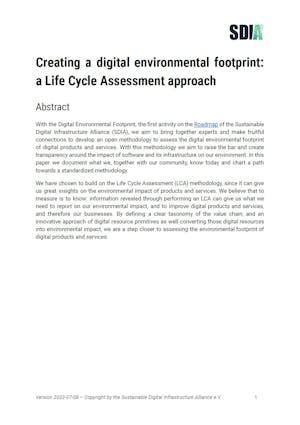
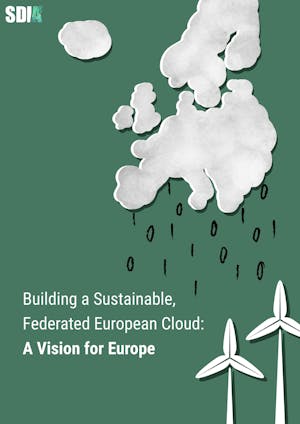
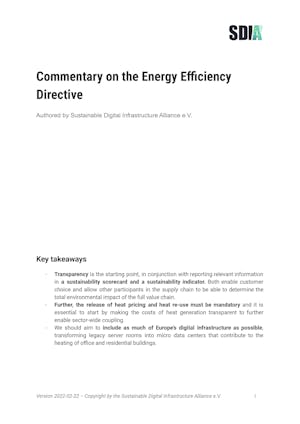
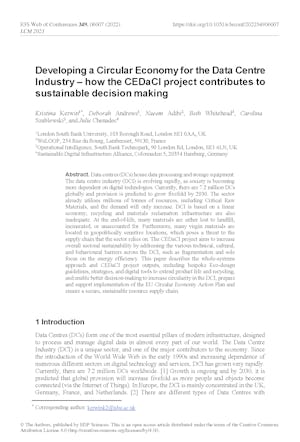
_Cover.png?ixlib=gatsbyFP&auto=compress%2Cformat&fit=max&rect=0%2C0%2C1512%2C2061&w=300&h=409)
_Image.png?ixlib=gatsbyFP&auto=compress%2Cformat&fit=max&rect=0%2C0%2C2477%2C3509&w=300&h=425)
-01.png?ixlib=gatsbyFP&auto=compress%2Cformat&fit=max&rect=0%2C0%2C1654%2C2338&w=300&h=424)
